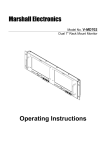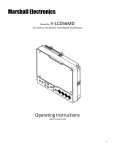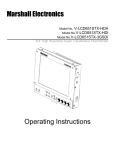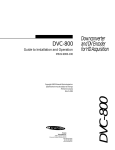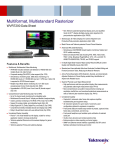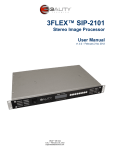Download Marshall Electronics V-MD171X Operating instructions
Transcript
Marshall Electronics V-MD171X 17” High Resolution Rack Mountable Monitor Operating Instructions Contents Installation and Initial Setup ..............................................................................................................3 Front Panel Features ..........................................................................................................................4 Rear Panel Features ...........................................................................................................................5 Input Module Installation....................................................................................................................6 Compatible Input Formats..................................................................................................................7 On-Screen Menu .................................................................................................................................8 STRUCTURE OVERVIEW ................................................................................................................8 MAIN MENU AND NAVIGATION .....................................................................................................9 VIDEO CONFIGURATION SUBMENU .............................................................................................9 MARKER CONFIGURATION SUBMENU ...................................................................................... 12 FILTER CONFIGURATION SUBMENU.......................................................................................... 16 SYSTEM CONFIGURATION SUBMENU ....................................................................................... 17 FUNCTION PRESETS SUBMENU ................................................................................................. 19 Specifications.................................................................................................................................... 20 Dimensions........................................................................................................................................ 21 Maintenance ...................................................................................................................................... 22 Warranty ............................................................................................................................................ 22 2 Installation and Initial Setup ■ Unpacking Carefully unpack the monitor and verify that the following items are included: • MD-171 Monitor • V-PS12-5V-XLR Power Supply with 4-Pin Male XLR Connector • Operating Instructions Inspect the unit for any physical damage that may have occurred during shipping. Should there be any damage, immediately call Marshall Electronics Customer Service at (800) 800-6608. If you are not located within the continental United States, call +1 (310) 333-0606. ■ Installation The V-MD171X can be mounted in any standard EIA 19” equipment rack. The attached rack ears can be angled to provide the user control over the viewing angle. Adequate ventilation is required when installed to prevent possible damage to the monitor’s internal components. A VESA standard 75mm hole pattern also allows custom mounting installations. Alternately, the V-MD171X can be used in a desktop configuration with optional stand (Marshall part number V-ST15). V-MD171X with optional desktop stand (Marshall Part Number V-ST15) ■ Input Slots Install any optional input modules BEFORE applying power to unit. Please see detailed instructions on Page 9. ■ Connections and Power-On Plug the V-PS12-5V-XLR power supply into an AC power source (100-240 V @ 50/60 Hz). Attach the 4-pin male twistlock connector to the back of the monitor. The monitor draws a maximum of 3.0 Amps at 12 Volts in operation. Connect the required cables for video signals, tally, etc. (Power must be applied to the V-MD171X for any of the active loop-through outputs to be activated.) All BNC connectors are rated at 75Ω. The unit defaults to ‘ON’ when power is supplied. 3 Front Panel Features Power Button Use the power button to toggle between ON and STANDBY modes. In both the STANDBY and the ON state, the LED on the button will illuminate bright green. This indicates that MAINS power is applied to the unit. Input Select Buttons Use the VIDEO, YPbPr, and S1/S2 buttons to select the corresponding analog or digital input. Video standards (NTSC/PAL, etc.) are automatically detected. S1/S2 select inputs connected to Optional Input Modules (located in Slot-1 or Slot-2). User-Definable Function Buttons Four user-definable function buttons can be used for direct access to various settings. Functions are assigned using the on-screen menu (Function Presets – Page 21). Menu Navigation Buttons Use the Menu, ▲, ▼, and Select buttons to display and navigate the on-screen menu (See Main Menu and Navigation – Page 12). 4 Image Adjustment Knobs Use the image adjustment knobs to adjust color brightness, color-saturation, tint, and contrast of the image. The status of each image adjustment parameter is shown on the bottom left of the screen, with values ranging from 0 to 100. Default value is 50. LED Tally Three LED tally lights (yellow, red, green) are available above the screen. Each tally light can be controlled independently from the rear Tally Connector. (See Tally Hardware Interface, Page 22.) Rear Panel Features Component and Composite Input and Output The V-MD171X has HD/SD component (YPbPr) and composite analog input. There is as an active loopthrough output for each analog input. See page 10 for supported video formats. The BNC inputs are internally terminated with 75 ohms. Outputs are active ONLY when power is supplied to unit. Programming Connector CN1* For Factory Use ONLY. *NOTE* although this appears to be a standard USB connector, It is NOT. Do not connect to any computer directly. Power Input Connect 12VDC to the 4-pin XLR power input connector. Power should only be supplied from the included power supply. Desktop Mounting Holes These holes are used when attaching the monitor to the optional desktop stand. See page 5 for details IMPORTANT: If using a power source other than the included power supply, damage may result. Please use the pin out diagram in the Specifications section of these Operating Instructions. VESA 75mm Hole Pattern VESA-standard 75 mm hole-pattern is provided to accommodate a variety of custom mounting options. Tally Input Connector (HD-15) The LED tally can be activated via the HD-15 connector by connecting the corresponding pin to ground. A variety of external devices can be used to perform the contact closure. No additional power should be supplied to the HD-15 port. See pin-out details on page 22. Input Slots, S1 and S2 The V-MD171X has 2 slots for optional input modules. These modules allow for a wide variety of input types and configurations. Modules are COLD swappable and must only be inserted or removed ONLY when Main Power is UPGLUGGED. 5 Input Module Installation 1. Remove Power From Unit Modules are cold-swappable only. Damage will occur if modules are inserted or removed while unit is powered. 2. Remove Blank Module Cover Using Philips screwdriver, remove the 4-40x1/8” screws. There are a total of three screws, save them for later use. Remove blank cover 3. Insert Optional Module Decide which slot you intend to install module (Slot 1 or Slot 2) Carefully align the module with the chosen slot. The raised rails will fit inside the module Align the Module so that the three (3) mounting holes all line up with the threaded holes of the slot. The connectors on both the module and the main-board slot should now be in alignment. Carefully PRESS the module into the slot. Module will seat flush with the rear of the unit. Replace the three (3) screws removed in Step 2. *NOTE* Use ONLY 4-40x1/8” screws provided. Any screw longer than 1/8” will damage the main unit. 6 Compatible Input Formats CVBS and YPbPr Analog Inputs VIDEO : NTSC 480i 59.94, PAL 525i 50 YPbPr: 480i 59.94, 576i 50 480p59.94, 576p50 720p (60 / 59.94 / 50 / 30 / 29.97 / 25) 1080i (60 / 59.94 / 50) 1080p (30 / 29.97 / 25 / 24 / 24sF / 23.98 / 23.98 sF) MD-3GSDI-A and MD-TC-A– 3G/HD/SDI Input Module and 3G/HD/SDI Telecube Input module SD-SDI – 480i 59.94, 576i 50 HD-SDI – 720p (60 / 59.94 / 50 / 30 / 29.97 / 25) 1080i (60 / 59.94 / 50) 1080p (30 / 29.97/ 25 / 24 / 24sF/ 23.98 / 23.98sF) 3G-SDI – YCbCr (4:2:2) 10 Bit – Level A and B 1080p (60 / 59.94 / 50) YCbCr/RGB (4:4:4) 10 Bit – Level A and B 1080i (60 / 59.94 / 50) 1080p (30 / 29.97 / 29.97sF / 25 / 25sF / 24 / 24sF / 23.98 / 23.98sF) MD-HDSDIx2-A – Two-channel HDSDI Input Module with Switched Output SD-SDI – 480i 59.94, 576i 50 HD-SDI – 720p (60 / 59.94 / 50 / 30 / 29.97 / 25) 1080i (60 / 59.94 / 50) 1080p (30 / 29.97/ 25 / 24 / 24sF/ 23.98 / 23.98sF) MD-DVII-A – DVI-I Input Module DVI-D Video (YCbCr or RGB) 480p 59.94, 576p50 720 (59.94 / 60 / 50 / 25 / 29.97 / 30 ) 1080i (50 / 59.94 / 60) 1080p (23.97 / 24,/ 29.97 / 30 / 24 / 24sF / 23.98 / 23.98sF) PC Formats – DVI-D and DVI-A 640 x 480 60, 72, 75 800 x 600 60, 72, 75 1024 x 768 60 70 1280 x 1024 60 1600 x 1200 60 1920 x 1200 60 MD-HDMIx2-A – Two-channel HDMI Input Module HDMI Video (YCbCr or RGB) 480p 59.94, 576p50 720 (59.94 / 60 / 50 / 25 / 29.97 / 30 ) 1080i (50 / 59.94 / 60) 1080p (23.97 / 24,/ 29.97 / 30 / 24 / 24sF / 23.98 / 23.98sF) PC Formats – DVI-D 640 x 480 60, 72, 75 800 x 600 60, 72, 75 1024 x 768 60 70 1280 x 1024 60 1600 x 1200 60 1920 x 1200 60 7 On-Screen Menu STRUCTURE OVERVIEW 1 Disabled when Color Temperature is set to Linear Disabled when Pixel to Pixel is ON 3 Available only with Composite NTSC or PAL Input 4 Available only with Composite NTSC Input 2 8 On-Screen Menu (continued) MAIN MENU AND NAVIGATION Access the main menu by pushing the MENU button on the front panel of the monitor. • Step through menu items using the ▲ and ▼ buttons. • Choose a submenu or select a menu item by pressing SELECT. • Return to the previous menu by pressing MENU. • Exit the main menu by pressing MENU. The menu will automatically time out after approximately 15 seconds. Main Menu VIDEO CONFIGURATION SUBMENU Video Configuration Submenu ■ Color Temperature Use this setting to choose one of five color temperature presets: • • • • • D65 (5500K) D55 (6500K) D93 (9300K) USER (Adjustable Color Bias and Gain) Linear ■ Gamma Use this setting to choose one of four selectable Gamma tables: • 2.2 • 2.4 • 1.8 • 2.0 Note: Gamma is disabled when Color Temperature is set to Linear 9 On-Screen Menu (continued) ■ RGB Bias and Gain Select this submenu to fine-tune the monitor’s color balance (R, G, B). This should only be done by someone experienced with video engineering, as this will alter the overall color shading of the screen. The purpose is to allow color matching to other types of monitors and/or displays. Note: The Color Temperature preset will automatically switch to USER when Color Bias settings are adjusted. It is normal for color bias adjustments to be very subtle. When selecting the RGB Bias and Gain submenu, gain adjustment indicators will appear at the top of the screen, and bias adjustment indicators will appear at the bottom of the screen: RED GREEN BLUE ALL RGB Bias and Gain Submenu Use the ▲ and ▼ buttons to select each individual bias or gain control. Press SELECT to begin adjusting the control. Use the ▲ and ▼ buttons to increase or decrease the value. Alternately, the image adjustment knobs (Brightness, Color, Tint, Contrast) can be used to easily adjust the bias and gain settings as shown below. The knobs affect whichever row of controls (gain or bias) is currently selected. Note: RGB Gain and Bias is disabled when Color Temperature is set to Linear. ■ Check Field Use the check field modes for monitor calibration or to analyze individual color components of an image. In Monochrome mode, all color is disabled and only a grayscale image is shown. In Blue, Green, and Red check field modes, only the selected color will be shown. ■ Ratio (Aspect Ratio Settings) Use to switch between Full Screen, 4:3 and 16:9 aspect ratios. As the V-MD171X monitor has a native resolution of 1920 x 1200 RGB pixels, incoming images are automatically scaled to fit the screen: 10 • In Full Screen, images are scaled to fill the entire screen. • In 4:3 mode, images are scaled to fill the maximum 4:3 portion of the screen, with black bars filling the remainder of the screen edges. • In 16:9 mode, images are scaled to fill the maximum 16:9 portion of the screen (1920 x1080), with black bars filling the remainder of the screen. On-Screen Menu (continued) Full Screen 4:3 Mode 16:9 Mode Note: The aspect ratio setting is ignored when Pixel-to-Pixel mode is ON. ■ Pixel-to-Pixel Mode Use this setting to enable Pixel-to-Pixel mode. This mode bypasses the monitor’s internal scaling function and displays incoming images in their native resolution and aspect ratio, with a one-to-one mapping: • For incoming formats smaller than the native resolution of the LCD panel (1920 x 1200), the image will be displayed in the center of the screen using only the necessary LCD pixels. For example, NTSC images will occupy exactly 720 x 480 pixels. The surrounding pixels will be black. Note: Pixel-to-Pixel mode disables aspect ratio control and H/V Delay. ■ H/V Delay Use this setting to enable one of three delay modes (H & V Delay, V Delay, H Delay): • In H & V Delay mode, both horizontal sync and vertical sync are delayed, resulting in both horizontal and vertical blanking periods being shown on the screen. • In V Delay mode, vertical sync is delayed so that the vertical blanking period is displayed on screen. • In H Delay mode, horizontal sync is delayed so that the horizontal blanking period is displayed on the screen. Notes: H/V Delay is disabled when Pixel-to-Pixel mode is ON. H/V Delay is only available with Composite inputs (NTSC or PAL) ■ Underscan Use this setting to enable or disable Underscan mode: • When Underscan is OFF, the active portion of the video signal is displayed on the screen, with 0% overscan. • When Underscan is ON, the image size is slightly reduced. This allows the user to clearly view the edges of the active video area. Note: Underscan is only available with Composite inputs (NTSC or PAL) 11 On-Screen Menu (continued) ■ NTSC Black Level Set the NTSC Black Level according to the type of NTSC composite video input: • 7.5 IRE: Use this setting for standard NTSC-M signals which use a 7.5 IRE setup (black level). • 0 IRE: Use this setting for NTSC-J signals which have no setup, or a black level of 0 IRE. Note: This setting is disabled for PAL composite input and all component/3G-SDI formats. MARKER CONFIGURATION SUBMENU Marker Configuration Submenu ■ Markers Use this setting to enable or disable all on-screen markers. This setting affects the center marker, full screen markers, 16:9 markers, and 4:3 markers. ■ Center Marker Use this setting to display a center marker on the screen. ■ 16:9 Markers Use these settings to superimpose one of the selectable markers on the screen when in 16:9 ratio mode. • • • • • • • • • • • • • 12 Off (no marker) 4:3 13:9 14:9 1.85:1 2.35:1 95% Safe 93% Safe 90%Safe 88% Safe 85% Safe 80% Safe User On-Screen Menu (continued) MARKER CONFIGURATION SUBMENU (continued) 16:9 Marker Examples: OFF (No Marker) 2.35:1 Aspect Ratio 4:3 Aspect Ratio Markers 90% Safe Area ■ Full Screen Markers Use this setting to superimpose one of the selectable markers on the screen when in Full Screen ratio mode. This setting is disabled when the aspect ratio is set to 16:9, or when Pixel-to-Pixel, Underscan, or H/V Delay is enabled. • • • • • • • • Off (no marker) 95% Safe Area 93% Safe Area 90% Safe Area 88% Safe Area 85% Safe Area 80% Safe Area User 4:3 Marker Examples: OFF (No Marker) 90% Safe Area ■ 4:3 Markers Use this setting to superimpose one of the selectable markers on the screen when in 4:3 ratio mode. This setting is disabled when the aspect ratio is set to 16:9, or when Pixel-to-Pixel, Underscan, or H/V Delay is enabled. • • • • • • • • Off (no marker) 95% Safe Area 93% Safe Area 90% Safe Area 88% Safe Area 85% Safe Area 80% Safe Area User 13 On-Screen Menu (continued) MARKER CONFIGURATION SUBMENU (continued) ■ Marker Background Use this setting to choose how outer edges of the markers are displayed on the screen: • • • • • 100% 75% 50% 25% 0% Image area beyond the marker is shown at solid black Image area beyond the marker is shown at 50% Transparent overlay Only The marker is superimposed on the image. Example (80% Marker in 4:3 Mode): Normal Background Black Background User Markers User markers enable the user to create their own safe areas on the screen. 1. Choose the User option for your selected aspect ratio (Full Screen, 4:3 or 16:9) in the Marker Configuration submenu and press the SELECT button. You may also begin with an already predefined safe area (95%, 93%, 90%, etc.) and make your adjustments from there by highlighting a particular safe area and pressing the SELECT button. 2. Use the BRIGHT, COLOR, TINT and CONTRAST knobs to move the LEFT, RIGHT, TOP and BOTTOM borders of the safe area to your desired position. When you have reached the desired location for the borders, press the MENU button. If you began the marker adjustment using one of the predefined safe areas and made an adjustment, the marker selection will automatically convert to the User marker setting. 14 15 On-Screen Menu (continued) FILTER CONFIGURATION SUBMENU ■ False Colors This monitor has a false color filter to aid in the setting of camera exposure. As the camera Iris is adjusted, elements of the image will change color based on the luminance or brightness values. This enables proper exposure to be achieved without the use of costly, complicated external equipment. To best utilize this feature, you must understand the color chart below and have a basic understanding of camera exposure. Normally, when shooting subjects like people, it is common practice to set exposure of faces to the equivalent of approximately 56 IRE. The false color filter will show this area as the color PINK on the monitor. Therefore, as you increase exposure (open the IRIS), your subject will change color as indicated on the chart: PINK, then GREY, then a few shades of YELLOW. Over exposed subjects (above 101 IRE) on the monitor will be shown as RED. In addition, underexposed subjects will show as DEEP-BLUE to DARK–BLUE, with clipped-blacks indicated with a FUCHSIA-like color. Lastly, the color GREEN is used to indicate elements of the image that are approximately 45 IRE. This represents a ‘neutral’ or ‘mid-level’ exposure commonly used for objects (not people). False Color Key 16 On-Screen Menu (continued) FILTER CONFIGURATION SUBMENU (continued) ■ Mosquito Filter Use this setting to filter out “Mosquito Noise” – an artifact that appears as specs around edges of objects. This artifact is the result of video that has been compressed at some point. Video sources from DVD-Players, PDA’s, Digital Cable Boxes, Camcorders, etc. often have this artifact. SYSTEM CONFIGURATION SUBMENU System Configuration Submenu ■ Input Format OSD Use this option to enable on-screen display of input/format status in the upper-left corner of the screen. Options are: Off, On or 5 Sec. When 5 Sec selected, On Screen display whenever a new input is received, then after approximately 5 seconds, the text wit disappear. ■ Curtain Color Selects the color of the screen whenever there is no input, or if input is lost. Choices are: Blue, Black or Green. ■ Splash Screen The Splash Screen is what is displayed when the monitor is first powered. The text “Marshall Electronics” is displayed along with the model name of the unit. This feature can be turned off. 17 On-Screen Menu (continued) SYSTEM CONFIGURATION SUBMENU (continued) ■ Freeze Input Use the Freeze function to “freeze” the current image on the screen. Select this menu item again (Off) to return to the real-time video input. ■ Load Setup Up to 6 User Setups can be stored on this monitor. Load Setup allows instant recall of any of the 6 saved configurations (User 1-6). Also available is the ability to load factory default settings. (MFG Default) ■ Save Setup Up to 6 User Setups can be stored on this monitor. Save Setup allows the current configuration to be saved in one of 6 named locations in memory. (User 1-6). Settings are saved even if power is lost from the unit. ■ Power on Preset Selects what preset configuration is loaded each time the monitor is powered. Choices are: Off – (last used configuration), User 1-6, or MFG Default. 18 On-Screen Menu (continued) FUNCTION PRESETS SUBMENU ■ Function Presets Allows user to assign menu items to the front panel function buttons: F1, F2, F3 and F4. The following options are available for each button: • • • • • • Ratio Check Field Mosquito Filter False Colors Freeze Input Aspect Markers • • • • • Center Marker Markers Underscan H/V Delay Pixel-to-Pixel 19 Specifications ■ PANEL Screen Size Display Area (h x v) Aspect Ratio Pixels Viewing Angle (h x v) Brightness Contrast Ratio Dot Pitch (h x v) Pixel Pitch (h x v) 17.0” Diagonal 367.20 x 229.50 mm 16:10 Native (4:3/16:9 Selectable) 1920 x RGB x 1200 140° x 120° 2 330 cd/m 500:1 0.064 x 0.191 mm 0.191 x 0.191 mm ■ VIDEO INPUT/OUTPUT Video Input / Output (Composite) Supports SMPTE 170M, NTSC/PAL YPBPR Input / Output (Component) Supports SMPTE 260M, 274M, 296M ■ CONNECTORS Video Input Video (Composite) YPBPR (Component) 1 x BNC Female (75 Ω) 3 x BNC Female (75 Ω) ■ ELECTRICAL Power Consumption ON: 3.5 Amp @ 12VDC (42 W Max) Voltage Requirement 12VDC V-PS12-5V-XLR Power Supply: Input 100V-240V, 1.5A, 50-60Hz Output 12VDC, 5A, 60W Max Power Input 4-Pin XLR Video Output (Active Loop-Through) Video (Composite) 1 x BNC Female (75 Ω) YPBPR (Component) 3 x BNC Female (75 Ω) S1, S2 (Module Slots) For Marshall I/O Modules Only Cold-Swap – remove power from unit before Inserting or removing Modules. Power Input 4-Pin XLR Connector ■ MECHANICAL Dimensions (w x h x d): 18.84” x 10.45” x 1.00” Tally Hardware Interface HD-15 Female CN-1 – Programming Port* * NOT USB – Factory Use Only Weight (Monitor Only): 7.5 lbs Additional Mounting: Desk Stand Marshall Part # V-ST15 Standard VESA 75mm Mount ■ TALLY HARDWARE INTERFACE (HD-15) Activation requires contact closure of pin to ground on the HD-15 connector: Operating Temperature 32° F to 104° F (0° C to 40° C) Storage Temperature -4° F to120° F (-20° C to 50° C) RoHs 20 Do not dispose. Return to Manufacturer or Authorized Recycle Facility. Dimensions 21 Maintenance ■ Screen Cleaning Periodically clean the screen surface using ammonia-free cleaning wipes (Marshall Part No. V-HWP-K). A clean microfiber cloth can also be used using only non-abrasive and ammonia-free cleaning agents. Do not use paper towels. Paper towel fibers are coarse and may scratch the surface of the panel or leave streaks on the surface. Antistatic and fingerprint resistant cleaning agents are recommended. Do not apply excessive pressure to the screen to avoid damaging the LCD. Warranty Marshall Electronics warranties to the first consumer that this V-MD171X LCD monitor will, under normal use, be free from defects in workmanship and materials, when received in its original container, for a period of one year from the purchase date. This warranty is extended to the first consumer only, and proof of purchase is necessary to honor the warranty. If there is no proof of purchase provided with a warranty claim, Marshall Electronics reserves the right not to honor the warranty set forth above. Therefore, labor and parts may be charged to the consumer. This warranty does not apply to the product exterior or cosmetics. Misuse, abnormal handling, alterations or modifications in design or construction void this warranty. It is considered normal for a minimal amount of pixels, not to exceed three, to fail on the periphery of the display active viewing area. Marshall Electronics reserves the option to refuse service for display pixel failure if deemed unobtrusive to effective use of the monitor by our technicians. No sales personnel of the seller or any other person is authorized to make any warranties other than those described above, or to extend the duration of any warranties on behalf of Marshall Electronics, beyond the time period described above. Due to constant effort to improve products and product features, specifications may change without notice. Marshall Electronics, Inc. 1910 East Maple Ave. El Segundo, CA 90245 Tel: (800) 800-6608 / (310) 333-0606 • Fax: 310-333-0688 www.LCDRacks.com • [email protected] V2 22























